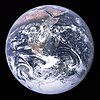Natural environment

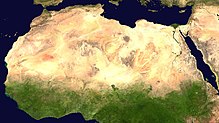
The natural environment or natural world encompasses all living and non-living things occurring naturally, meaning in this case not artificial. The term is most often applied to Earth or some parts of Earth. This environment encompasses the interaction of all living species, climate, weather and natural resources that affect human survival and economic activity.[1] The concept of the natural environment can be distinguished as components:
- Complete ecological units that function as natural systems without massive civilized human intervention, including all vegetation, microorganisms, soil, rocks, the atmosphere, and natural phenomena that occur within their boundaries and their nature.
- Universal natural resources and physical phenomena that lack clear-cut boundaries, such as air, water, and climate, as well as energy, radiation, electric charge, and magnetism, not originating from civilized human actions.
In contrast to the natural environment is the built environment. Built environments are where humans have fundamentally transformed landscapes such as urban settings and agricultural land conversion, the natural environment is greatly changed into a simplified human environment. Even acts which seem less extreme, such as building a mud hut or a photovoltaic system in the desert, the modified environment becomes an artificial one. Though many animals build things to provide a better environment for themselves, they are not human, hence beaver dams, and the works of mound-building termites, are thought of as natural.
People cannot find absolutely natural environments on Earth, and naturalness usually varies in a continuum, from 100% natural in one extreme to 0% natural in the other. The massive environmental changes of humanity in the Anthropocene have fundamentally effected all natural environments: including from climate change, biodiversity loss and pollution from plastic and other chemicals in the air and water. More precisely, we can consider the different aspects or components of an environment, and see that their degree of naturalness is not uniform.[2] If, for instance, in an agricultural field, the mineralogic composition and the structure of its soil are similar to those of an undisturbed forest soil, but the structure is quite different.
Composition
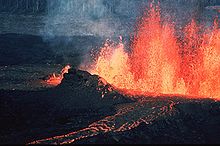
Earth science generally recognizes four spheres, the
Geological activity
The
Water on Earth

Most water is found in various kinds of natural body of water.
Oceans
An ocean is a major body of
Rivers
A river is a natural
or another river. A few rivers simply flow into the ground and dry up completely without reaching another body of water.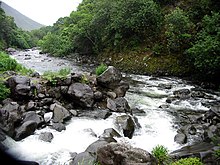
The water in a river is usually in a
Small rivers may also be called by several other names, including
Lakes

A lake (from Latin lacus) is a
Natural lakes on Earth are generally found in mountainous areas, rift zones, and areas with ongoing or recent glaciation. Other lakes are found in endorheic basins or along the courses of mature rivers. In some parts of the world, there are many lakes because of chaotic drainage patterns left over from the last ice age. All lakes are temporary over geologic time scales, as they will slowly fill in with sediments or spill out of the basin containing them.
Ponds
A pond is a body of standing water, either natural or human-made, that is usually smaller than a lake. A wide variety of human-made bodies of water are classified as ponds, including water gardens designed for aesthetic ornamentation, fish ponds designed for commercial fish breeding, and solar ponds designed to store thermal energy. Ponds and lakes are distinguished from streams by their current speed. While currents in streams are easily observed, ponds and lakes possess thermally driven micro-currents and moderate wind-driven currents. These features distinguish a pond from many other aquatic terrain features, such as stream pools and tide pools.
Human impact on water
Humans impact the water in different ways such as modifying rivers (through
Atmosphere, climate and weather
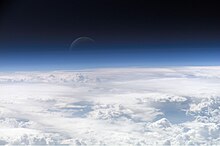

The atmosphere of the Earth serves as a key factor in sustaining the planetary ecosystem. The thin layer of
The ozone layer of the Earth's atmosphere plays an important role in reducing the amount of ultraviolet (UV) radiation that reaches the surface. As DNA is readily damaged by UV light, this serves to protect life at the surface. The atmosphere also retains heat during the night, thereby reducing the daily temperature extremes.
Layers of the atmosphere
Principal layers
Earth's atmosphere can be divided into five main layers. These layers are mainly determined by whether temperature increases or decreases with altitude. From highest to lowest, these layers are:
- Exosphere: The outermost layer of Earth's atmosphere extends from the exobase upward, mainly composed of hydrogen and helium.
- exobase. Its height varies with solar activity and ranges from about 350–800 km (220–500 mi; 1,150,000–2,620,000 ft). The International Space Station orbits in this layer, between 320 and 380 km (200 and 240 mi). In other way, the thermosphere is Earth's second highest atmospheric layer, extending from approximately 260,000 feet at the mesopause to the thermopause at altitudes ranging from 1,600,000 to 3,300,000 feet.[14]
- Stratosphere: The stratosphere extends from the tropopause to about 51 km (32 mi; 167,000 ft). The stratopause, which is the boundary between the stratosphere and mesosphere, typically is at 50 to 55 km (31 to 34 mi; 164,000 to 180,000 ft).
- Troposphere: The troposphere begins at the surface and extends to between 7 km (23,000 ft) at the poles and 17 km (56,000 ft) at the equator, with some variation due to weather. The troposphere is mostly heated by transfer of energy from the surface, so on average the lowest part of the troposphere is warmest and temperature decreases with altitude. The tropopause is the boundary between the troposphere and stratosphere.
- Other layers
Within the five principal layers determined by temperature there are several layers determined by other properties.
- The ozone layer is contained within the stratosphere. It is mainly located in the lower portion of the stratosphere from about 15–35 km (9.3–21.7 mi; 49,000–115,000 ft), though the thickness varies seasonally and geographically. About 90% of the ozone in our atmosphere is contained in the stratosphere.
- The ionosphere: The part of the atmosphere that is ionized by solar radiation, stretches from 50 to 1,000 km (31 to 621 mi; 160,000 to 3,280,000 ft) and typically overlaps both the exosphere and the thermosphere. It forms the inner edge of the magnetosphere.
- The homosphere and heterosphere: The homosphere includes the troposphere, stratosphere, and mesosphere. The upper part of the heterosphere is composed almost completely of hydrogen, the lightest element.
- The planetary boundary layer is the part of the troposphere that is nearest the Earth's surface and is directly affected by it, mainly through turbulent diffusion.
Effects of global warming
The dangers of
- The prevent dangerous anthropogenic interference with the climate system.[20]
- The Kyoto Protocol, which is the protocol to the international Framework Convention on Climate Change treaty, again with the objective of reducing greenhouse gases in an effort to prevent anthropogenic climate change.[21]
- The Western Climate Initiative, to identify, evaluate, and implement collective and cooperative ways to reduce greenhouse gases in the region, focusing on a market-based cap-and-trade system.[22]
A significantly profound challenge is to identify the natural environmental dynamics in contrast to environmental changes not within natural variances. A common solution is to adapt a static view neglecting natural variances to exist. Methodologically, this view could be defended when looking at processes which change slowly and short time series, while the problem arrives when fast processes turns essential in the object of the study.
Climate

Climates can be classified according to the average and typical ranges of different variables, most commonly temperature and precipitation. The most commonly used classification scheme is the one originally developed by Wladimir Köppen. The Thornthwaite system,[24] in use since 1948, uses evapotranspiration as well as temperature and precipitation information to study animal species diversity and the potential impacts of climate changes.[25]
Weather
Weather is a set of all the phenomena occurring in a given atmospheric area at a given time.[26] Most weather phenomena occur in the troposphere,[27][28] just below the stratosphere. Weather refers, generally, to day-to-day temperature and precipitation activity, whereas climate is the term for the average atmospheric conditions over longer periods of time.[29] When used without qualification, "weather" is understood to be the weather of Earth.
Weather occurs due to density (temperature and moisture) differences between one place and another. These differences can occur due to the sun angle at any particular spot, which varies by latitude from the tropics. The strong temperature contrast between polar and tropical air gives rise to the
Surface
Life
Evidence suggests that
Although there is no universal agreement on the definition of life, scientists generally accept that the biological manifestation of life is characterized by organization, metabolism, growth, adaptation, response to stimuli and reproduction.[31] Life may also be said to be simply the characteristic state of organisms. In biology, the science of living organisms, "life" is the condition which distinguishes active organisms from inorganic matter, including the capacity for growth, functional activity and the continual change preceding death.[32][33]
A diverse variety of living organisms (life forms) can be found in the
Ecosystems

An
Central to the ecosystem concept is the idea that
The human ecosystem concept is then grounded in the deconstruction of the human/nature dichotomy, and the emergent premise that all species are ecologically integrated with each other, as well as with the abiotic constituents of their biotope.
A more significant number or variety of species or biological diversity of an ecosystem may contribute to greater resilience of an ecosystem because there are more species present at a location to respond to change and thus "absorb" or reduce its effects. This reduces the effect before the ecosystem's structure changes to a different state. This is not universally the case and there is no proven relationship between the species diversity of an ecosystem and its ability to provide goods and services on a sustainable level.
The term ecosystem can also pertain to human-made environments, such as human ecosystems and human-influenced ecosystems. It can describe any situation where there is relationship between living organisms and their environment. Fewer areas on the surface of the earth today exist free from human contact, although some genuine wilderness areas continue to exist without any forms of human intervention.
Biogeochemical cycles

Global biogeochemical cycles are critical to life, most notably those of water, oxygen, carbon, nitrogen and phosphorus.[36]
- The nitrogen cycle is the transformation of nitrogen and nitrogen-containing compounds in nature. It is a cycle which includes gaseous components.
- The water cycle, is the continuous movement of water on, above, and below the surface of the Earth. Water can change states among liquid, vapour, and ice at various places in the water cycle. Although the balance of water on Earth remains fairly constant over time, individual water molecules can come and go.
- The carbon cycle is the biogeochemical cycle by which carbon is exchanged among the biosphere, pedosphere, geosphere, hydrosphere, and atmosphere of the Earth.
- The oxygen cycle is the movement of oxygen within and between its three main reservoirs: the atmosphere, the biosphere, and the lithosphere. The main driving factor of the oxygen cycle is photosynthesis, which is responsible for the modern Earth's atmospheric composition and life.
- The phosphorus cycle is the movement of phosphorus through the lithosphere, hydrosphere, and biosphere. The atmosphere does not play a significant role in the movements of phosphorus, because phosphorus and phosphorus compounds are usually solids at the typical ranges of temperature and pressure found on Earth.
Wilderness
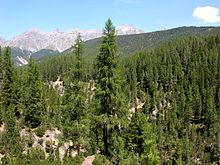

The word, "wilderness", derives from the notion of wildness; in other words that which is not controllable by humans. The word's etymology is from the Old English wildeornes, which in turn derives from wildeor meaning wild beast (wild + deor = beast, deer).[39] From this point of view, it is the wildness of a place that makes it a wilderness. The mere presence or activity of people does not disqualify an area from being "wilderness". Many ecosystems that are, or have been, inhabited or influenced by activities of people may still be considered "wild". This way of looking at wilderness includes areas within which natural processes operate without very noticeable human interference.

Challenges
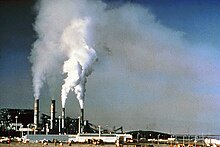

It is the common understanding of natural environment that underlies
Goals for the benefit of people and natural systems, commonly expressed by
- Elimination of pollution and toxicants in air, water, soil, buildings, manufactured goods, and food.
- Preservation of biodiversity and protection of endangered species.
- land, air, energy, raw materials, and natural resources.
- Halting human-induced global warming, which represents pollution, a threat to biodiversity, and a threat to human populations.
- Shifting from public transportation and distributed generation, which have benefits for traffic congestion and electric reliability.
- Shifting from meat-intensive diets to largely plant-based diets in order to help mitigate biodiversity loss and climate change.[43]
- Establishment of nature reserves for recreational purposes and ecosystem preservation.
- Sustainable and less polluting composting, waste-to-energy, and anaerobic digestionof sewage sludge.
- Reducing
- Slowing and stabilisation of human population growth.[45]
- Reducing the import of second hand electronic appliances from developed countries to developing countries.[46][47]
Criticism
In some cultures the term environment is meaningless because there is no separation between people and what they view as the natural world, or their surroundings.[48] Specifically in the United States and Arabian countries many native cultures do not recognize the "environment", or see themselves as environmentalists.[49]
See also
- Citizen's dividend
- Conservation movement
- Environmental history of the United States
- Gaia hypothesis
- Greening
- Index of environmental articles
- List of conservation topics
- List of environmental books
- List of environmental issues
- List of environmental websites
- Natural capital
- Natural history
- Natural landscape
- Sustainability
- Sustainable agriculture
- Timeline of environmental history
- Geological engineering
References
- .
- ISBN 0-19-502535-0.
- ^ Earth's Spheres Archived 2007-08-31 at the Wayback Machine. Wheeling Jesuit University/NASA Classroom of the Future. Retrieved November 11, 2007.
- ^ "What is Earth Science? | Geology Buzz". Archived from the original on 2021-12-24. Retrieved 2021-12-24.
- ^ ""Page Jaffna | Srilanka's Top Tamil Online News Paper". Archived from the original on 2012-07-14. Retrieved 2012-07-15.". The Columbia Encyclopedia. 2002. New York: Columbia University Press
- ^ "Distribution of land and water on the planet Archived May 31, 2008, at the Wayback Machine". UN Atlas of the Oceans Archived September 15, 2008, at the Wayback Machine
- ^ River {definition} Archived 2010-02-21 at the Wayback Machine from Merriam-Webster. Accessed February 2010.
- ^ "What is hydrology and what do hydrologists do?". United States Geological Survey. Archived from the original on April 27, 2012. Retrieved July 27, 2021.
- ^ Britannica Online. "Lake (physical feature)". Archived from the original on 2008-06-11. Retrieved 2008-06-25.
[a Lake is] any relatively large body of slowly moving or standing water that occupies an inland basin of appreciable size. Definitions that precisely distinguish lakes, ponds, swamps, and even rivers and other bodies of nonoceanic water are not established. It may be said, however, that rivers and streams are relatively fast-moving; marshes and swamps contain relatively large quantities of grasses, trees, or shrubs; and ponds are relatively small in comparison to lakes. Geologically defined, lakes are temporary bodies of water.
- ^ "Dictionary.com definition". Archived from the original on 2008-06-17. Retrieved 2008-06-25.
a body of fresh or salt water of considerable size, surrounded by land.
- ^ ISBN 0-262-57138-2.
- ^ NGDC – NOAA. "Volcanic Lightning". National Geophysical Data Center – NOAA. Archived from the original on December 25, 2007. Retrieved September 21, 2007.
- ^ Joe Buchdahl. "Atmosphere, Climate & Environment Information Programme". Ace.mmu.ac.uk. Archived from the original on 2010-10-09. Retrieved 2013-03-09.
- ^ "Thermosphere - an overview | ScienceDirect Topics". www.sciencedirect.com. Retrieved 2023-07-25.
- ^ "Mesosphere - an overview | ScienceDirect Topics". www.sciencedirect.com. Retrieved 2023-07-25.
- ^ "Mesosphere | NASA Space Place – NASA Science for Kids". spaceplace.nasa.gov. Retrieved 2023-07-25.
- ^ "World's Space Agencies Unite To Face The Climate Challenge – ISRO". www.isro.gov.in. Archived from the original on 2020-09-25. Retrieved 2019-12-10.
- ^ "Climate Change". sites.google.com. Archived from the original on 2023-02-17. Retrieved 2019-01-08.
- ^ Forthofer, Ron. "It's Time To Act On Global Warming". Boulder Daily Camera. Archived from the original on 2013-06-16. Retrieved 2013-10-28.
- ^ United Nations Framework Convention on Climate Change Archived 2018-02-01 at the Wayback Machine Retrieved August 2008.
- ^ Kyoto Protocol Archived 2009-08-25 at the Wayback Machine from United Nations Framework Convention on Climate Change Archived 2018-02-01 at the Wayback Machine, Retrieved August 2008.
- ^ Western Climate Initiative Archived 2008-04-23 at the Wayback Machine, Retrieved on Feb 12, 2009.
- ^ a b "What's the Difference Between Weather and Climate?". National Centers for Environmental Information (NCEI). 2018-03-09. Archived from the original on 2021-04-22. Retrieved 2021-04-22.
- JSTOR 210739.
- ISBN 9788499485676.
- ^ Merriam-Webster Dictionary. Weather. Archived 2017-07-09 at the Wayback Machine Retrieved on 2008-06-27.
- ^ Glossary of Meteorology. Hydrosphere. Archived 2012-03-15 at the Wayback Machine Retrieved on 2008-06-27.
- ^ Glossary of Meteorology. Troposphere. Archived 2012-09-28 at the Wayback Machine Retrieved on 2008-06-27.
- ^ "Climate". Glossary of Meteorology. American Meteorological Society. Retrieved 2008-05-14.
- ^ "History of life through time Archived 2015-05-03 at the Wayback Machine". University of California Museum of Paleontology.
- ^ "Definition of Life". California Academy of Sciences. 2006. Archived from the original on 2007-02-08. Retrieved 2007-01-07.
- ^ The Concise Oxford Dictionary. English Edition 1991[full citation needed]
- ^ "Merriam-Webster Dictionary". Merriam-Webster Dictionary. Archived from the original on 2021-12-13. Retrieved 2009-06-21.
- ISBN 0-13-505314-5.
- ISBN 0-7216-6941-7.
- ISBN 978-0-7167-5079-6.
- ^ "The WILD Foundation". Wild.org. Archived from the original on 2012-12-04. Retrieved 2013-03-09.
- ISBN 978-1-55963-465-6.
- ^ wilderness Archived 2012-10-20 at the Wayback Machine. CollinsDictionary.com. Collins English Dictionary – Complete & Unabridged 11th Edition. Retrieved November 29, 2012.
- ^ "Why the Amazon Rainforest is So Rich in Species : News". Earthobservatory.nasa.gov. 2005-12-05. Archived from the original on 2011-02-25. Retrieved 2013-03-09.
- ^ "Why The Amazon Rainforest Is So Rich In Species". Sciencedaily.com. 2005-12-05. Archived from the original on 2019-07-14. Retrieved 2013-03-09.
- .
- ^ Drayer, Lisa (January 2, 2019). "Change your diet to combat climate change in 2019". CNN. Archived from the original on February 13, 2019. Retrieved February 14, 2019.
- ^ Plumer, Brad (May 6, 2019). "Humans Are Speeding Extinction and Altering the Natural World at an 'Unprecedented' Pace". The New York Times. Archived from the original on June 14, 2019. Retrieved June 14, 2019.
- hdl:11336/71342.
It is also time to re-examine and change our individual behaviors, including limiting our own reproduction (ideally to replacement level at most)...
- ^ "The Rich World's Electronic Waste, Dumped in Ghana". Bloomberg.com. 2019-05-29. Archived from the original on 2023-04-16. Retrieved 2023-05-06.
- ^ "India: E-waste provides poor children a dangerous living – DW – 02/09/2023". dw.com. Archived from the original on 2023-05-06. Retrieved 2023-05-06.
- ISBN 9780262195522
- ISBN 9780791444153
Further reading
- Adams, Simon; David Lambert (2006). Earth Science: An illustrated guide to science. New York NY 10001: Chelsea House. p. 20. ISBN 0-8160-6164-5.)
{{cite book}}: CS1 maint: location (link
- Allaby, Michael, and Chris Park, eds. A dictionary of environment and conservation (Oxford University Press, 2013), with a British emphasis.
- "Earth's Energy Budget". Oklahoma Climatological Survey. 1996–2004. Retrieved 2007-11-17.
- Oldroyd, David (2006). Earth Cycles: A historical perspective. Westport, Connicticut: Greenwood Press. ISBN 0-313-33229-0.
- Simison, W. Brian (2007-02-05). "The mechanism behind plate tectonics". Retrieved 2007-11-17.
- Smith, Gary A.; Aurora Pun (2006). How Does the Earth Work? Physical Geology and the Process of Science. Upper Saddle River, NJ 07458: Pearson Prentice Hall. p. 5. ISBN 0-13-034129-0.)
{{cite book}}: CS1 maint: location (link
External links
 Media related to Environment at Wikimedia Commons
Media related to Environment at Wikimedia Commons- UNEP - United Nations Environment Programme
- BBC - Science and Nature.
- Science.gov – Environment & Environmental Quality

